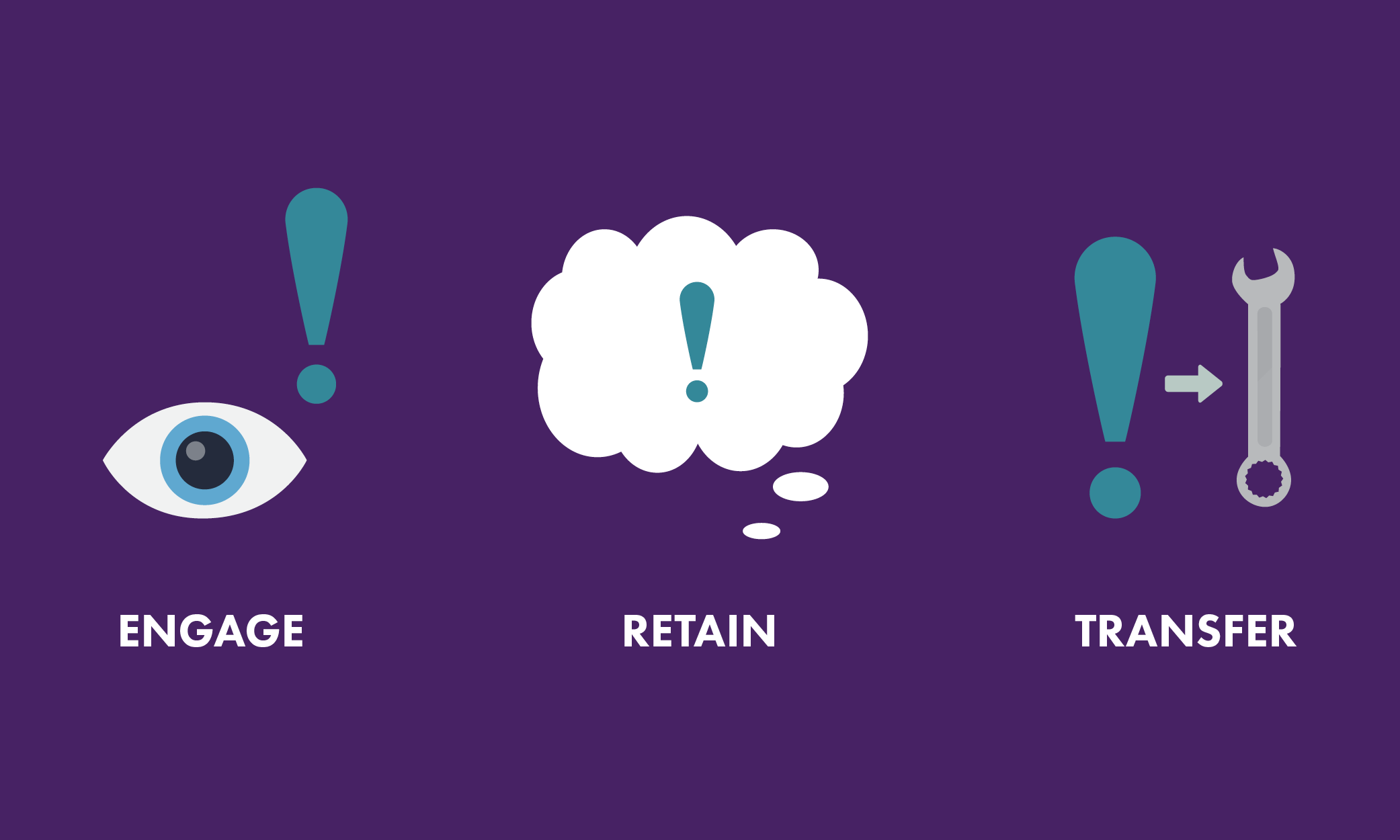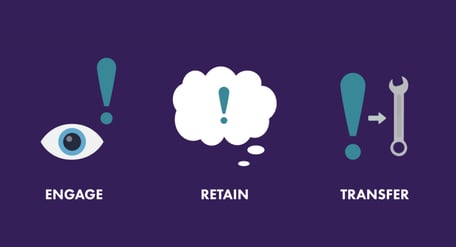
No, you don't have an engagement problem.
You do not have an engagement problem with your compliance training.
You might have a problem, but that’s not it.
The vast majority of what people think are “engagement” problems are actually “transfer” problems. Practically, this means that employees are paying attention—they just don’t know what to do.
What’s the difference?
They’re different stages in the learning process. Here’s how people learn, vastly simplified:

“Engagement” is all about the first step in learning—getting someone’s attention. This is, honestly, not that tough; anything shiny and loud is engaging.
“Transfer,” on the other hand, is about the last step in learning—getting someone to apply what they learned, correctly, in the real world. This is tough, but you can't get compliance without it.
If you don't feel like your training makes a difference, the problem probably isn't engagement—it's transfer.
"But I don’t even have engagement!"
It might feel like no one pays attention to you, but they do—at least enough to mean that's it's not your real problem.
For example, do you require employees to complete training? If so, you are literally requiring them to pay attention to you. Engagement achieved!
And even if you don’t require that, and even if your compliance training is just a bunch of footnote-heavy slides that your lawyers made, most employees are smart enough to know that they should at least try to pay attention to what the compliance person is saying.
So again, your problem isn’t engagement; you have their attention.
The problem is that once you have their attention, nothing happens.
This occurs when your training isn’t obviously useful or applicable to their jobs. As a result, the work they need to do to remember it and apply it to their job tasks correctly is too much—so they can't do it, even if they try.
It’s a transfer problem.
Why does it matter?
You can’t fix a problem unless you diagnose it correctly. And when you mix up transfer and engagement, you end up doing increasingly ridiculous things without getting results. You'll chase every training fad and wonder why nothing works.
It’s like when you see tourists who don’t know the language—so they try to communicate with the locals by just speaking English louder.

That’s what you look like when you try to fix transfer problems with engagement. You look like an American blaring DOOO YOUUUU SPEEEEAAAAK ENGLISHHHH to a befuddled shopkeeper over and over, a little louder each time.
You have their attention. You're just speaking the wrong language.
So how do I fix it?
First, go to our session at the SCCE conference, two weeks from the date we're publishing this. We're the last session on Monday, #408 ("Keeping Compliance Simple"), and we’ll go through this in depth. But if you can’t make it, here are the basics.

1. Commit to what your problem really is.
Stop worrying about whether your training is boring. It might be—but so what? Make it useful first, and then worry about making it fun.
Street signs are pretty boring, but they’re useful—so they get used. Don't worry about having interactive e-learning adventure games until your training is at least as useful as a street sign. And most training fails that test.
So first, remember that your problem is not engagement. It's transfer.

2. Don't try to build an army of compliance professionals.
A lot of people try to train their employees the same way they learned—basically, by telling them about risks. But your goal is not to make your company full of compliance professionals; it’s to get your salespeople to sell compliantly, your engineers to engineer compliantly, and so on.
You need to meet them on their terms instead of just saying “here’s a risk, you figure it out.” If they magically knew how to apply risks to their jobs, you wouldn’t need compliance training in the first place—you could just sign them up for law firm email updates.
You can't achieve transfer by making everyone think like you—so don't try.

3. Frame your training around tasks.
Compliance does not happen at the risk or job function level; it happens at the task level.
You do not get in trouble because anticorruption risk exists or because you have salespeople; you get in trouble because a salesperson approved a third-party invoice with an obvious red flag in it, and because accounts payable didn’t catch it, and because as a result you approved a bribe.
The task there is “reviewing an invoice for red flags.” You can train someone to get better at that. And then they can easily transfer that training to real life, because it's framed around a real task that they do.
And bonus: you can audit and incentivize that task, too—and easily. It's a measurable job duty that people can be good or bad at. That's how performance management works.
In truth, a lot of the “how do I know if my program is working” issues folks struggle with are a function of thinking too high-level about compliance. Getting gritty fixes that; all of this stuff is infinitely easier when you drill down to where things really happen.
We’ll go into that last point in great detail, as well as how to use your risk assessment to operationalize it and use your auditors to measure it, at our session.
We’ll see you there—last session on Monday, #408.

